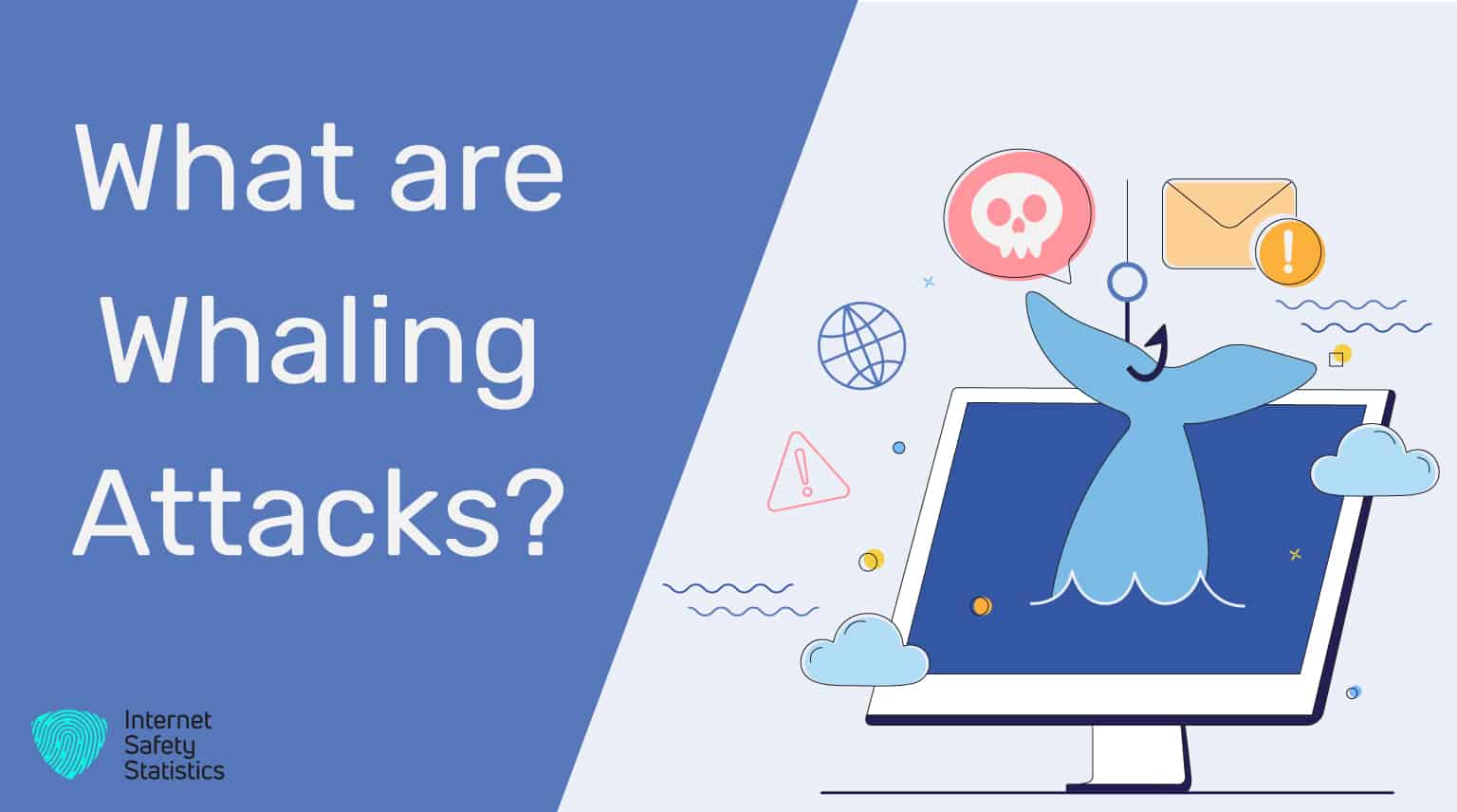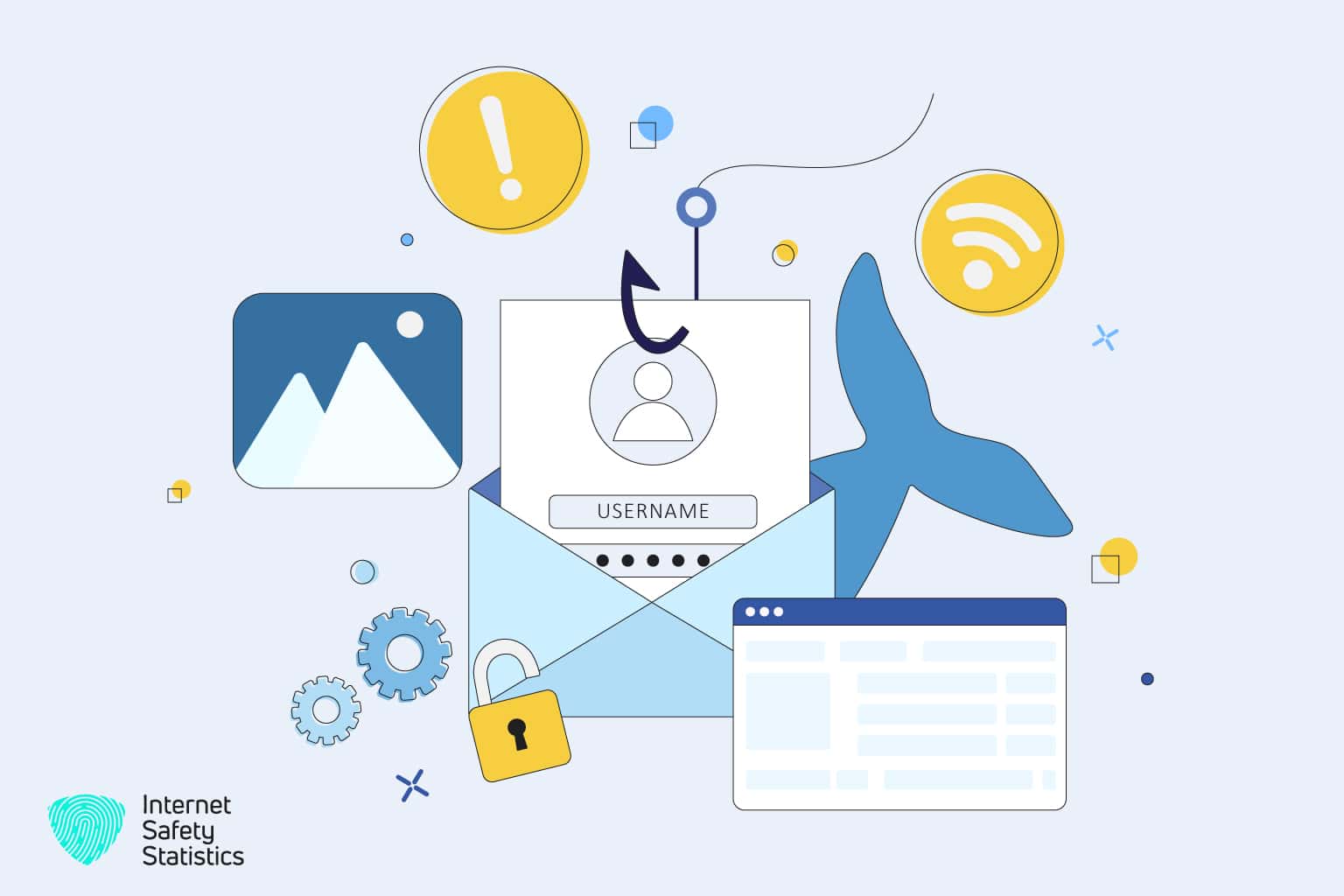
One sophisticated and targeted cyber threat that poses a significant risk to organisations and high-profile individuals is “Whaling Attacks.” Whaling attacks are a form of phishing attacks that specifically target top-level executives, high-ranking officials, or prominent individuals within an organisation.
What are Whaling Attacks?
Whaling attacks are a type of cyber-attack where attackers focus on a specific “big fish” or high-value target rather than casting a wide net to catch random victims. The term “whaling” is derived from the analogy of fishing for large, valuable whales in the vast ocean of potential targets.
These attacks are carefully crafted to trick the targets into divulging sensitive information, such as login credentials, financial data, or other confidential information, which can then be exploited for malicious purposes. Unlike traditional phishing attempts, whaling attacks are highly tailored and personalised, making them more convincing and difficult to detect.
Whaling attacks have become a growing concern for organisations across industries due to their potential to cause severe financial and reputational damage. High-profile targets, such as CEOs, CFOs, and other C-suite executives, are often entrusted with critical decisions and access to sensitive data, making them lucrative targets for cybercriminals.
The consequences of a successful whaling attack can be dire, ranging from financial losses through unauthorised transactions to compromised business operations, reputational harm, and even legal ramifications. As these attacks continue to evolve in sophistication, it is essential for organisations and individuals to be vigilant and adopt robust cybersecurity measures to defend against this specific type of cyber threat. Understanding the nature of whaling attacks is the first step towards implementing effective preventive strategies and protecting valuable assets from falling prey to cybercriminals.

How Does it Work?
Whaling attacks are a type of highly targeted and sophisticated cyber-attack that specifically targets high-profile individuals in organisations, such as CEOs, CFOs, and other top-level executives. These attacks aim to deceive the targets into divulging sensitive information or carrying out fraudulent activities. Here’s how whaling attacks typically work:
- Research and Targeting: Cybercriminals conduct extensive research on their targets to gather information from publicly available sources. They may analyse the target’s social media profiles, corporate websites, or professional networking platforms to understand their roles, responsibilities, and connections within the organisation.
- Crafting Deceptive Emails: Armed with the gathered information, attackers craft highly personalised and convincing emails. They use various Social Engineering tactics to create a sense of urgency, authority, or familiarity in the messages. The emails often appear to be from a trusted source, such as the CEO or another high-ranking executive.
- Email Spoofing and Impersonation: To make the emails appear authentic, cybercriminals may use email spoofing techniques. They alter the sender’s email address to make it look like it is coming from a legitimate source. Additionally, they may create deceptive domains that closely resemble the target’s organisation or use similar names to trusted entities.
- Urgency and Criticality: Whaling attackers create a sense of urgency in their emails, demanding immediate action from the target. For example, they may request an urgent financial transaction, ask for sensitive information, or prompt the target to click on a malicious link or download a harmful attachment.
- Psychological Manipulation: Whaling attackers leverage psychological manipulation to trick the targets into complying with their requests. They may exploit emotions such as fear, curiosity, or a sense of duty to override the target’s natural scepticism and critical thinking.
- Bypassing Email Security Measures: Whaling attacks are highly targeted, which makes them difficult to detect using traditional email security measures. The personalised nature of the emails and the use of email spoofing often bypass spam filters and other security protocols.
- Consequences: If the target falls for the deception and follows the attacker’s instructions, the consequences can be severe. The attacker may gain access to sensitive information, carry out fraudulent financial transactions, or compromise the organisation’s security.
To mitigate the risks of whaling attacks, organisations need to implement robust cybersecurity measures, including employee training on recognising phishing attempts and social engineering tactics. It is crucial to raise awareness about the existence of whaling attacks and ensure that employees are vigilant when dealing with sensitive information or acting on email requests, especially those involving financial transactions or password sharing.
Real-Life Examples
Real-life examples of whaling attacks have targeted prominent individuals and organisations, resulting in significant financial losses and reputational damage. Here are some notable instances:
- Ubiquiti Networks: In 2015, cybercriminals impersonated the CFO of Ubiquiti Networks and sent emails to employees requesting a series of wire transfers. The attackers successfully manipulated the recipients into wiring over $46 million to offshore accounts.
- Mattel: In 2015, the toy manufacturer Mattel fell victim to a whaling attack. The attacker impersonated the CEO and sent an email requesting a large payment to be made to a Chinese supplier. The finance department complied, resulting in a substantial financial loss.
- Snapchat: In 2016, an employee at Snapchat was targeted by a whaling attack. The attacker impersonated the CEO and requested payroll information for current and former employees. As a result, the attacker obtained the sensitive data of several employees.
- Seagate Technology: In 2016, a whaling attack targeted Seagate Technology, a data storage solutions provider. The attacker impersonated a senior executive and requested W-2 tax forms for all employees. The HR department unwittingly provided the information, compromising thousands of employees’ personal data.
- FACC AG: In 2016, the Austrian aerospace parts manufacturer FACC AG suffered a whaling attack. The attackers impersonated the CEO and requested a transfer of approximately €50 million to an account in Asia. The finance department initiated the transfer before realising it was a scam.
- Snapchat and Twitter: In 2017, a hacker group known as “OurMine” targeted high-profile Twitter accounts, including those of Snapchat and Twitter’s CEOs. They gained unauthorised access to the accounts and posted false messages.
- Intuit Payroll Services: In 2020, Intuit, the financial software company, experienced a whaling attack. The attackers posed as employees and requested changes to direct deposit information, leading to unauthorised payments to the attackers’ accounts.

These examples demonstrate how cybercriminals have exploited the trust and authority associated with high-level executives to manipulate employees into carrying out their malicious intentions. The financial consequences and damage to a company’s reputation can be severe, emphasising the need for robust security measures and employee training to prevent falling victim to whaling attacks.
Motives Behind Whaling Attacks
Whaling attacks, also known as CEO fraud or BEC (Business Email Compromise), are carefully orchestrated cyberattacks with specific motives targeting high-profile individuals within organisations. The primary motives behind whaling attacks include:
- Financial Gain: The most common motive behind whaling attacks is financial gain. By impersonating a high-ranking executive or CEO, cybercriminals aim to trick employees into making unauthorised wire transfers or payments to their accounts. These attacks can lead to significant financial losses for the targeted organisation.
- Access to Sensitive Information: Whaling attacks may also aim to gain access to sensitive and confidential information, such as financial records, trade secrets, or customer data. The attackers can exploit this information for further cybercrimes or sell it on the dark web.
- Corporate Espionage: In some cases, competitors or hostile entities may orchestrate whaling attacks to gather strategic information or sensitive data about a target organisation. This information can be used for corporate espionage or to gain a competitive advantage in the market.
- Disruption and Sabotage: Whaling attacks can be carried out to disrupt business operations and cause chaos within an organisation. By impersonating key executives, attackers may send false instructions or malicious content that can lead to system downtime or data breaches.
- Reputation Damage: Whaling attacks can be used to tarnish the reputation of a high-profile individual or the organisation they represent. Cybercriminals may send damaging or embarrassing messages under the guise of the targeted executive, causing reputational harm.
- Ransom Demands: In some instances, whaling attacks may involve ransom demands. Cybercriminals may threaten to release sensitive information or disrupt business operations unless a ransom is paid.
- Spear Phishing: Whaling attacks are often carried out through spear-phishing emails, where attackers customise messages based on detailed research about the target. These attacks are tailored to exploit specific weaknesses or vulnerabilities in the individual’s behaviour or role within the organisation.
It is crucial for organisations to be aware of these motives behind whaling attacks and implement robust security measures, including employee training, email authentication protocols, and multi-factor authentication, to prevent falling victim to such scams. Additionally, fostering a culture of cybersecurity awareness can help employees recognise and report suspicious activities, reducing the risk of successful whaling attacks.
Tactics and Techniques Used in Whaling Attacks
Whaling attacks are sophisticated cybercrimes that utilise various tactics and techniques to deceive their targets. The following points explain the tactics and techniques commonly used in whaling attacks:
A. Social Engineering and Reconnaissance on Targets: Whaling attackers employ social engineering tactics to gather detailed information about their targets. They conduct thorough reconnaissance on high-profile individuals within the organisation, such as CEOs, CFOs, or other top executives. By mining publicly available information from social media, company websites, and professional networks, attackers build a comprehensive profile of their targets’ roles, responsibilities, and relationships.
B. Email Spoofing and Domain Impersonation: One of the primary techniques used in whaling attacks is email spoofing, where attackers forge the email headers to make the messages appear as if they are sent from a legitimate source. They often use domain impersonation by registering domains similar to the target organisation’s domain to trick recipients into believing the email is genuine.
C. Advanced Phishing Techniques and Spear-Phishing: Whaling attacks go beyond traditional phishing attempts. Cybercriminals use advanced phishing techniques and spear-phishing to craft highly personalised and convincing emails. These emails are tailored to match the target’s communication style and context, making them difficult to detect as malicious.
D. Psychological Manipulation and Urgency: Attackers create a sense of urgency and authority in their emails to manipulate the targets into immediate action. They may claim urgent financial transactions, legal matters, or critical business decisions requiring immediate attention. By exploiting the busy schedules of high-profile individuals, attackers aim to bypass regular security protocols and evoke an emotional response for quick compliance.
E. Credential Harvesting and Account Takeover: Whaling attackers may trick their targets into divulging login credentials or other sensitive information through fake login pages or deceptive requests. Once they obtain valid credentials, the attackers can gain unauthorised access to critical accounts and systems, compromising data and potentially conducting further attacks.
F. Business Email Compromise (BEC) Tactics: Whaling attacks often fall under the broader category of Business Email Compromise (BEC). In BEC, attackers leverage social engineering to manipulate employees, vendors, or customers into changing payment instructions or performing fraudulent financial transactions.
G. Impersonation of Higher Authorities: By impersonating a higher authority, such as the CEO or company board members, attackers exert influence and bypass regular security protocols. This gives the illusion of legitimacy to their requests, making it more likely for employees to comply without suspicion.
To defend against whaling attacks, organisations should implement robust security measures, including employee training on phishing awareness, Multi-Factor Authentication (MFA) for critical accounts, and email authentication protocols such as Domain-Based Message Authentication, Reporting, and Conformance (DMARC). Furthermore, organisations should continuously monitor and update their security infrastructure to detect and prevent whaling attacks effectively.

Detecting and Preventing Whaling Attacks
Detecting and preventing whaling attacks requires a proactive and multi-layered approach to cybersecurity. Organisations can adopt the following strategies to enhance their defence against these sophisticated attacks:
A. Employee Training on Identifying Phishing Attempts: Educating employees about whaling attacks and the risks associated with phishing is crucial. Conducting regular training sessions to raise awareness about the tactics used in whaling attacks can empower employees to recognise suspicious emails. They should be taught to scrutinise emails from unknown sources, validate unusual requests, and report any suspicious activity immediately. By fostering a culture of security awareness, employees become the first line of defence against whaling attacks.
B. Implementing Email Security and Authentication Protocols: Robust email security solutions play a pivotal role in detecting and blocking whaling attacks. Organisations can deploy advanced email security systems that use artificial intelligence and machine learning algorithms to analyse incoming emails for signs of phishing attempts. Additionally, the use of Domain-based Message Authentication, Reporting, and Conformance (DMARC) and Sender Policy Framework (SPF) can help prevent email spoofing and domain impersonation.
C. Multi-Factor Authentication and Verification for Critical Actions: Implementing multi-factor authentication (MFA) is a fundamental practice for protecting critical accounts and sensitive data. MFA adds an extra layer of security by requiring users to provide additional verification, such as a one-time code sent to their mobile device, in addition to their login credentials. By enforcing MFA for critical actions like financial transactions or data access, organisations can significantly reduce the risk of unauthorised access and fraudulent activities.
D. Advanced Threat Detection and User Behaviour Analytics: Investing in advanced threat detection solutions and user behaviour analytics can help identify anomalous activities and potential whaling attacks. These tools continuously monitor user behaviour, network activities, and email communications to detect suspicious patterns or deviations from normal behaviour. By leveraging artificial intelligence and machine learning, these systems can quickly detect whaling attacks and respond promptly to mitigate potential threats.
E. Incident Response and Contingency Plans: Incorporating incident response and contingency plans specific to whaling attacks is essential for effective mitigation. Organisations should establish a well-defined incident response team that can quickly respond to suspected whaling attacks. Incident response plans should include procedures for isolating affected systems, mitigating damages, and conducting thorough post-incident analysis to prevent future attacks.
F. Regular Security Audits and Penetration Testing: Conducting regular security audits and penetration testing helps identify vulnerabilities and weak points in an organisation’s security infrastructure. By simulating real-world whaling attacks through penetration testing, organisations can assess their security readiness and make necessary improvements.
G. Vendor and Third-Party Security: Third-party vendors and suppliers can serve as potential entry points for attackers to infiltrate an organisation. Therefore, it is crucial to establish robust security standards for vendors and conduct due diligence when selecting third-party partners.
By implementing these preventive measures and fostering a security-conscious organisational culture, businesses can significantly reduce the risk of falling victim to whaling attacks and safeguard their critical assets and sensitive data.
